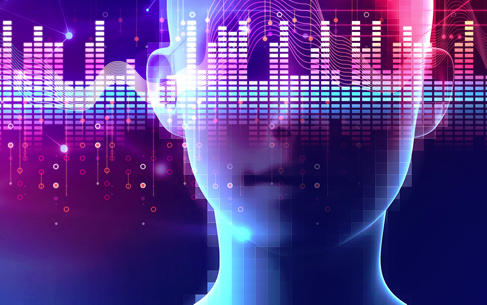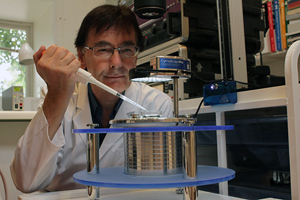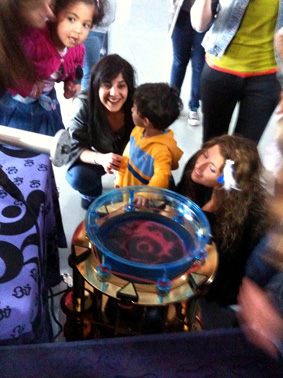SOUND HEALING
| |

Master's Quotes
Swami Satchidananda has called music "the celestrial sound that controls the whole universe"
“Vibrate the cosmos and the cosmos shall clear the path.” ~Yogi Bhajan
“The gong is the first and last instrument for the human mind. There is only one thing that can supersede and command the human mind-the sound of the gong. It is the first sound in the universe, the sound that created this universe. It is the basic creative sound. To the mind, the sound of the gong is like a mother and father that gave it birth. The mind has no power to resist a gong that is well played.” ~Yogi Bhajan
“You have no resistance against this sound (the gong). It is the master sound, the adi naad. Everything you think becomes zero—the gong prevails.” ~Yogi Bhajan
“Music is the mediator between the life of the senses and the life of the spirit.” ~Beethoven
- Reduces stress
- Deeply relaxing
- Soothes, purifies and harmonizes emotions and feelings
- Cleanses negative energies and emotions
- Strengthens immune system
- Stimulates circulation
- Heals at the cellular level by significantly increasing red blood cells and activating white blood cellsAdditional benefits:
- Balances both hemispheres of the brain
- Clears old patterns of behavior, habits and thought patterns that no longer serves us.
- Connects us to our Higher Self
- Speeds up recovery after illness, traumas and invasive medical treatments
- Improves sleep
- Increases vital energy flow, creativity, intuition and motivation
- Removes blockages and toxins
- Soothes, purify and harmonies emotions and feelings
- Stimulates endocrine glands and regulates hormonal functioning
- Changes brain waves and quickly reaches high meditatiive states of alpha and deltaThe sound of gongs, Himalayan and crystal singing bowls vibrates in a line with meridians in the body and it helps balancing them. It unleashes Kundalini, which sleeps dormant at your root chakra, and it then ascends up the central energy channel along your spine. This can be felt as slight tingling in the muscles or slight discomfort, if there are any blockages along the energy line.
The gong is a sacred and ancient instrument of healing, rejuvenation and transformation. The gong is the greatest synthesizer in the world. It synthesizes everything so that it comes into functional harmony. To heal is to make whole, so where there is functional harmony and holistic resonance, healing takes place naturally.
The vibrations of the gong are space filling. Multiple tones and clusters of overtones build as the gong is played, eventually creating a plasma of total sound, which can be directly felt kinaesthetically by the person receiving the gong healing. Natural harmonics are overtones, which normally go upwards until they dissolve into friction. This is the natural process of aging. The pure living tones of the gong delay this degenerative process of natural harmonics thereby bringing us more energy, youthfulness and healing.
On a physical level, the gong releases tension and blocks in the body, it stimulates a higher functioning of the glandular and nervous system, it increases prana, our vital life force and improves circulation.
The gong also works deeply on the mental, emotional and spiritual bodies. The gong purifies and quietens the mind. It literally cuts through the linear mind and clears the clutter from the subconscious mind to reveal the radiant and authentic self. It has the capacity to bring us to our neutral mind that is wise and non-judgmental. It helps turn the mind to zero, a state of stillness where innate wisdom can be accessed. Another benefit that comes from the mind stilling, is repair at the DNA and cellular level allowing deep healing to take place.
Sound therapy is also beneficial for deaf or people with hearing impaired. Even if they don't hear the sound, they can still feel the vibrations.
Within the name of GONG lies the sacred seed ONG. Ong is creative consciousness manifested. It is the penetration of the Om power in the material world. When you listen deeply to the gong, the sound of Ong is reverberating and penetrating our being helping to raise our consciousness.
The sound of Ong that emanates from the gong has a direct impact on the third eye, the pituitary and pineal glands. This subsequently increases our intuition and connection to divine and universal knowledge. It brings us beyond time and space. It brings us bliss and union.
[top]
Blood Testing with Sacred Sounds. Richard Rudis
Gong Bath - Blood Testing - Before and After, Part 1 of 2
Gong Bath - Blood Testing - Before and After, Part 2 of 2
[top]
Arjan Kaur: The Gong Bath at The Portal to Ascension Conference
The Portal to Ascension Conference 2018 presented revolutionary,
paradigm shifting awareness in Irvine, California.PTA included presenters, vendors and amazing musicians....
including The Didgeridoo Experience AND The Gong Experience facilitated by Arjan Kaur
[top]
During a Sound Healing session
A typical Sacred Sound Journey session has profound effects on the body and the mind, Most people will reach a state of relaxation quickly. Even during their first session.he body will go through noticeable changes as it responds to deeper and deeper states of rest. Relaxation is not only a physical state but also a state of consciousness, and sound healing brings on the same kind of brain states as yoga, tai chi, and meditation. It is very important to understand the physiological responses to relaxation and how they relate to state of mind in order to react and respond in kind to your client. This kind of observation is part of the greater system of communication and feedback that is so vital to any form of sound therapy.
Most clients will start to relax as soon as the session begins. Their muscles will lose tension, and they may even start to slip into the alpha brain wave pattern within the first minutes. The alpha wave pattern is associated with daydreaming and pre-sleep. At this point the clients breathing and heart rate will start to slow down, and the body will begin to absorb the waves of vibration into its tissues. The slowing of breathing and lack of muscle tension are both signs that the metabolism is slowing. Insulin levels will rise, and cortisol levels will fall. As the heart rate slows, blood pressure falls and arteries expand giving rise to a feeling of warmth. This relaxed state allows the body to repair itself instead of responding to outside concerns. The immune system is at its best when we are relaxed.
Many people will fall asleep at some point during the session or go into a deep dream state. The theta brain wave state is associated with meditation, sleep, and deep relaxation. The delta brain state is a deeper form of sleep and is also associated with hypnosis and ritual. During normal sleep, people will oscillate between both of these states. The brain wave state of clients undergoing a sound healing will change naturally and in reaction to the modality as positions are changed and different gongs and singing bowls are introduced. Small tremors and shakes are common as people enter and exit the theta and delta brain rhythms.
Those who undergo a state of deep relaxation often report a feeling of mental freshness that they carry with them after the session is over. Relaxation and meditative states of mind have also been shown to increase the threshold for emotional response, meaning they can help us control our emotional responses to outside influences. Like other kinds of meditation, sound therapy can help us be more internally aware while being more present in the moment and more connected with our surroundings.
Post Gong Care
Take time after a gong healing to integrate the experience. Be in silence and rest to allow the benefits of the healing from the gong. Also drink plenty of water to help with the process of detoxification and healing that happens in the gong healing. If you feel spaced out, it is important to eat to ground yourself and put your feet on the earth.
[top]
Studies and Research
Studies Show We Can Heal With Sound, Frequency & Vibration
The Facts:
Multiple studies and examples have shown how sound, frequency and vibration can literally alter physical material matter. Research has also shown that sound, frequencies and vibration can be used as a significant healing method for various ailments.
Cymatics is a very interesting topic. It illustrates how sound frequencies move through a particular medium such as water, air, or sand and as a result directly alter physical matter. There are a number of pictures all over the internet as well as youtube videos that demonstrate how matter (particles) adjust to different sounds and different frequencies of sound.
Research has even demonstrated that drumming and singing can can be used to slow fatal brain disease, and it can generate a sense of oneness with the universe .
In repeated and controlled experiments, the frequencies, known as oscillating pulsed electric field (OPEF) technology, killed an average of 25% to 40% of leukemia cells, going as high as 60% in some cases. Furthermore, the intervention even slowed cancer cell growth rates up to 65%.
The researchers observed uterine cancer cells exposed to different acoustic instruments (guitar, gong, xylophone) as well as the human voice for 20-minute sessions.
They discovered that, when exposed to sound, cancer cells lost structural integrity until they exploded at the 14-minute mark. Far more dramatic was the sound of a human voice — the cells were destroyed at the nine-minute mark.
After this, they decided to work with two women with breast cancer. For one month, both of the women gave three-and-a-half-hours a day to “toning” or singing the scale. Apparently, the woman’s tumor became undetectable, and the other woman underwent surgery. Her surgeon reported that her tumor had shrunk dramatically and “dried up.” It was removed and the woman had a complete recovery and remission.
A 2011 Finnish study observed that stroke patients who were given access to music as cognitive therapy had improved recovery. Other research has shown that patients suffering from loss of speech due to brain injury or stroke regain it more quickly by learning to sing before trying to speak. The phenomenon of music facilitating healing in the brain after a stroke is called the “Kenny Rogers Effect.”
[top]
Cardiorespiratory optimization during improvised singing and toning
Study on Toning published in Scientific Reports
Published: August 17, 2017Dr Shelley Snow, Concordia University, Montreal, Quebec, Canada
The purpose of this study was to conduct basic research on toning, in order to establish a scientific foundation for the understanding of this phenomenon. This publication focuses on the cardiorespiratory data from the study. The key findings are that “Toning significantly improved heart rate variability, ventilatory efficiency, and slowed the respiration rate to almost exactly six breaths per minute, a pattern that is known to optimize cardiovascular function…”
Singing was found to also positively impact cardiorespiratory function, but to a lesser degree.
Six breaths per minute is a respiration rate found in other studies of meditative practices. It is a respiration rate that is recommended for people who want to improve their heart rate variability, Increased heart rate variability exerts a calming effect on the autonomic nervous system. Breathing at six breaths per minute is increasingly being linked to mental and emotional calm as well.
An important part of this finding relates to the fact that toning spontaneously resulted in a respiration rate of six breaths per minute. Moreover, the 20 participants in this study were ‘naïve’ in the sense that they had never engaged in toning before, and were not aware of potential benefits of toning. Thus, it was found that by simply engaging in seven minutes of toning open vowel sounds on the full exhalation of the breath, on pitches of the participants’ choosing, respiration rates went from normal rates (12 to 16 breaths per minute at rest) to six breaths per minute, a significant reduction.
These findings are unexpected, and stunning. Those of us who practice toning are certainly familiar with the natural process of the ‘lengthening’ of the breath, that occurs as we tone. To now have hard scientific data confirming this anecdotal evidence, is helpful indeed, in terms of its ability to extend the influence, impact and credibility of this most important health practice.
Stay tuned in the coming months for a second article from this same research team discussing many more findings from this large study. Thanks for your attention and interest!
Dr. Shelley Snow
From www.collegeofsoundhealing.co.uk/research.php
Download Shelly's Scientific Reports (8-page pdf 969 kiloBytes)
[top]
Healing Through Sound: An Exploration of a Vocal Sound Healing Method in Great Britain
April 2011
This thesis describes ethnographic research conducted on a vocal sound healing method practiced in Great Britain at the College of Sound Healing, founded by acupuncturist and sound healer Simon Heather.
This phenomenological, narrative inquiry embraces a perspective recognizing the dialogic nature of ethnographic research, and includes the perspective of sensory anthropology by exploring the role of the senses in sound healing.
The research also positions sound healing in relation to the field of music therapy, the career practiced by the researcher. The study involved a sample of individuals who had undergone sound healing. Interviews consisted of two parts: the participant's life story, and their experiences with sound healing. Data collection consisted of interviews and participant observation/sensation.
Findings of the study reflect a wide range of experiences which embrace a holistic conception of health encompassing both mind and body. Categories evolving out of participants' own language used to describe their experiences include the following: physical, mental, insight, emotional and spiritual.
Effects such as the release of emotions and trauma, a change from negative to more positive thought patterns, the elimination of physical pain, relaxing, calming effects and receiving deeper perceptions of life situations, are among the experiences described by participants.
Contributions to an evolving theory of sound healing include: The recognition that altered states of consciousness appear to play an important role in facilitating certain kinds of healing; the phenomenon of after-effects of sound healing which extend and evolve for sometimes days, weeks and even months after a sound healing session; the role of the senses in terms of healing efficacy, with colors experienced as healing in and of themselves; and an analysis of the relationship between intuition, intention and the sounds utilized in this method of sound healing.
Shelley Snow holds a Master's Degree in Music Therapy and a Doctorate in Music Therapy and Anthropology.
From www.collegeofsoundhealing.co.uk/research.php
Download Shelley's Doctoral Thesis (254-page pdf 1.1 megaBytes)
[top]
John Stuart Reid
Sound Healing at the Cellular Level
Following a seemingly miraculous healing of my lower back during an acoustic experiment in the Great Pyramid, 20-years ago I began to research the question "why does sound heal". I am still on that journey of exploration but I sense that I am edging closer to some fundamental answers. Traumatised cells are in a form of hibernation known as the G0 phase, or resting phase, in which they are asleep and not replicating.
To rejoin the normal cell cycle, leading to normal replication and healing, the cell requires stimulation, either by an "injection" of effective nutrition or, hypothetically, by exposure to audible sounds of the correct frequencies. I discussed this concept in detail at the Cymatics Conference in Atlanta and showed a read-out of the 'song' of a healthy cell, identifying the frequencies present, followed by the read-out of the same cell in a traumatised state, indicating which frequencies have changed.
Another avenue of exploration involves the outer membrane of a cell, its ‘brain’ as suggested by Dr. Bruce Lipton. Since audible sounds manifest naturally as a cymatic pattern on a membrane, we are employing a high-powered microscope to develop methods to image the micro-cymatics patterns that form on the surface of living cells, patterns that may energise depleted cells.
During my presentation I showed a video of sound frequencies manifesting on the cell membrane of the Aloe Vera plant and a video in which sound frequencies created by the AMI 1000 Sound Therapy instrument were made visible with a laboratory CymaScope. These two videos reveal the embedded geometries, which we have shown appear on cell membranes. The videos can be viewed at:
[top]
John Stuart Reid Research Projects
Can Music Influence the Longevity of Human Blood Cells?
CymaScope Autism and Deafness Research by John Stuart & Annaliese Shanda Reid
The CymaScope as a therapeutic instrument for the treatment of autism and severe deafness.
The CymaScope allows voice patterns, unique to each person, to be visually studied. This new technology can be used for phonology research - the study of speech sounds - and it is anticipated that this will lead to the development of successful therapies to support autistic children and deaf children in their acquisition of speech and language.
When the visual equivalent of vocal sounds or words can be created in real time it becomes possible for children to see the energy patterns of their own sounds on a computer screen. Some speech pathologists have suggested that such pattern recognition by the child could assist in the process of acquiring speech and language.
Marsha Steinberger, M.A. CCC-SLP, a Speech-Language Pathologist based in Las Vegas, USA, works with autistic children. "Since many children with autism are visual thinkers the CymaScope provides an ideal way to capitalize on their learning style. The visual feedback offered by this new instrument offers a real ray of hope to families with autistic children - if the child can see the sounds they are making it could greatly accelerate their ability to speak and acquire language."
CymaScope Music Made Visible App
We are collaborating with Special Yoga Ltd, a London-based centre who support children with ASD, Cerebral Palsy and other challenges. More information on the CymaScope Music Made Visible App is available on their web site.
[top]
Sonocytology - The Study of Cellular Sounds
the links below lead to external websites
Sidney De Haan Research Centre for Arts and Health - Singing and HealthThe Sidney De Haan Research Centre for Arts and Health has produced a series of downloadable guides, which offer guidance on setting up and running singing groups for people with a range of enduring health issues.
These are based on previous research, the learning from singing for health projects in the UK, and the practical experience of members of the Sidney De Haan Research Centre in establishing and evaluating community singing projects since 2004.
The guides will also be available as hard copies. Further information is available on their website.
The guides are available to download from the Natural Voice Practitioners' Network website:
- Singing and Mental Health - Ian Morrison and Stephen Clift
- Singing and people with COPD - Ian Morrison and Stephen Clift
- Singing and people with Dementia - Trish Vella-Burrows
- Singing and people with Parkinson's - Trish Vella-Burrows and Grenville Hancox
[top]
Other Research on Sound and Healing
Links below lead to external websites
Healing Frequencies and Videos
Jump to Healing Frequencies and Videos
[top]
Home | Events | About | Testimonials | Sound Healing | Gong Therapy | Chakra Healing | Crystal Bowls | Tibetan Bowls | Drumming
Chakra Healing | Media | Songs | Mantras | Breathing | Toning | Site Map | Contact
Facebook: Sound Journey ![]() sacredSoundJourney.com
sacredSoundJourney.com
Copyright© 2015 Sacred Sound Journey- All Rights Reserved ![]() Website Design: Computer Therapist Consulting
Website Design: Computer Therapist Consulting



